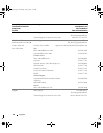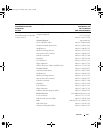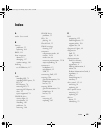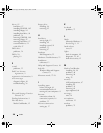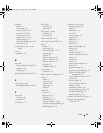
150 Glossary
memory — A temporary data storage area inside your
computer. Because the data in memory is not permanent,
it is recommended that you frequently save your files
while you are working on them, and always save your files
before you shut down the computer. Your computer can
contain several different forms of memory, such as RAM,
ROM, and video memory. Frequently, the word memory is
used as a synonym for RAM.
memory address — A specific location where data is
temporarily stored in RAM.
memory mapping — The process by which the computer
assigns memory addresses to physical locations at start-up.
Devices and software can then identify information that
the processor can access.
memory module — A small circuit board containing
memory chips, which connects to the system board.
MHz — megahertz — A measure of frequency that equals
1 million cycles per second. The speeds for computer
processors, buses, and interfaces are often measured in
MHz.
Mini PCI — A standard for integrated peripheral devices
with an emphasis on communications such as modems
and NICs. A Mini PCI card is a small external card that is
functionally equivalent to a standard PCI expansion card.
Mini-Card — A small card designed for integrated
peripherals, such as communication NICs. The Mini-
Card is functionally equivalent to a standard PCI
expansion card.
modem — A device that allows your computer to
communicate with other computers over analog
telephone lines. Three types of modems include: external,
PC Card, and internal. You typically use your modem to
connect to the Internet and exchange e-mail.
module bay — See media bay.
MP — megapixel — A measure of image resolution used
for digital cameras.
ms — millisecond — A measure of time that equals one
thousandth of a second. Access times of storage devices
are often measured in ms.
N
network adapter — A chip that provides network
capabilities. A computer may include a network adapter
on its system board, or it may contain a PC Card with an
adapter on it. A network adapter is also referred to as a
NIC (network interface controller).
NIC — See network adapter.
notification area — The section of the Windows taskbar
that contains icons for providing quick access to programs
and computer functions, such as the clock, volume
control, and print status. Also referred to as system tray.
ns — nanosecond — A measure of time that equals one
billionth of a second.
NVRAM — nonvolatile random access memory — A type
of memory that stores data when the computer is turned off
or loses its external power source. NVRAM is used for
maintaining computer configuration information such as
date, time, and other system setup options that you can set.
O
optical drive — A drive that uses optical technology to
read or write data from CDs, DVDs, or DVD+RWs.
Example of optical drives include CD drives, DVD drives,
CD-RW drives, and CD-RW/DVD combo drives.
P
partition — A physical storage area on a hard drive that is
assigned to one or more logical storage areas known as
logical drives. Each partition can contain multiple logical
drives.
PC Card — A removable I/O card adhering to the
PCMCIA standard. Modems and network adapters are
common types of PC Cards.
PCI — peripheral component interconnect — PCI is a
local bus that supports 32-and 64-bit data paths,
providing a high-speed data path between the processor
and devices such as video, drives, and networks.
book.book Page 150 Monday, July 23, 2007 3:47 PM



